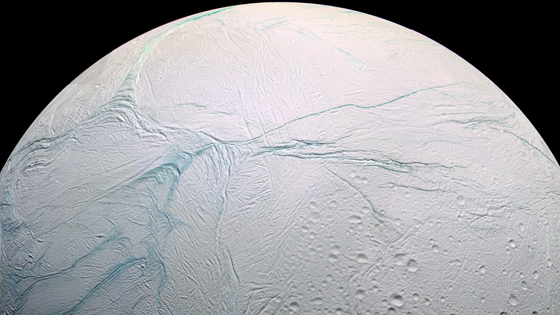HIDDEN OCEAN on one of SATURN’S MOON has been discovered
Enceladus! You sly piece of shit. You thought that you could simply fucking hide an ocean underneath your frozen space bollocks. What other sort of surprises are you not revealing? You seem chock fucking full of them! First plumes of water vapor, now this? Not bad for a moon that was thought to be geologically inactive like a fucking decade ago.
On a small moon of Saturn, hidden beneath nearly 25 miles of ice, researchers say they have identified an underground ocean of water that’s at least as large as Lake Superior, the largest of North America’s Great Lakes. The ocean was found at the south pole of Enceladus, a tiny moon about as wide as Arizona, putting the moon among the ranks of Saturn’s Titan and Jupiter’s Europa, which are also believed to hold oceans of water beneath frozen ice.
The research was led by Luciano Iess from the Sapienza University of Rome and was based on data from NASA’s Cassini spacecraft, which has been floating among Saturn’s moons for a decade now. Interest has grown around Enceladus since 2005, when researchers detected plumes of water vapor ejecting from long fractures in its surface known as tiger stripes. “This moon was believed to be geologically inactive — essentially a dead body,” Iess tells The Verge. “The fact that there are these geysers which eject more than a hundred kilometers over the surface was surprising.”
Iess and his colleagues determined the presence of liquid water while looking into a gravity anomaly around Enceladus’ south pole. The team noticed that there was not enough mass at the surface to account for the gravity they were detecting — some mass appeared to be missing — so they knew that something denser must also be present. Because liquid water is denser than ice, its presence is able to explain and correct the measured anomaly. The results are being published today in the journal Science.
Researchers found that the ocean of water is about 5 miles deep and extends at least from Enceladus’ south pole to around half way to its equator. It may actually go farther than that — potentially even reaching the equator — though they can’t say either way. They also can’t say whether this ocean is what feeds the plumes of mineral-rich water vapor coming out of the tiger stripes on Enceladus’ surface, though it’s certainly a possibility that the fractures reach low enough for the vapor to come from water escaping the ocean.
While above the ocean is miles and miles of water leading up to an inhospitable surface as cold as nearly minus 300 degrees Fahrenheit (minus 180 degrees Celsius), beneath the ocean is a rock core, and that mixture of water and rock creates a much more intriguing setting. After Europa, Enceladus is the second body in the solar system that we’ve discovered to have rock and water in contact. “These are among the most interesting objects from the point of view of astrobiology,” Iess says. [The Verge]




